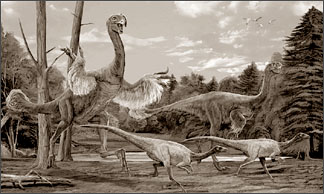Big dino bird unearthed in China
The fossilised remains of a giant bird-like dinosaur have been
uncovered in the region of Inner Mongolia, China.
|

Artist's reconstruction of Gigantoraptor with much smaller feathered
dinosaurs. |
While some have theorised that meat-eating dinosaurs got smaller as
they evolved to be more bird-like, this beast weighed about 1,400kg
(3,080lbs).
That is about 35 times heavier than other similar feathered
dinosaurs.
Nature journal reports that the beaked animal was 8m (26ft) long and
twice as tall as a man at the shoulder; yet it was only a young adult
when it died. The authors suggest the dinosaur's enormous size was due
to a fast growth rate, faster even than the precocious Tyrannosaurus
rex.
In truth, though, just what it ate is really mystery. Gigantoraptor
erlianensis had some features associated with meat-eating dinosaurs,
such as sharp claws for tearing flesh; but it also had some features
associated with plant-eaters, such as a small head and long neck.
Chinese researchers uncovered the fossilised remains of the
flightless giant in the Erlian basin in Inner Mongolia.
The researchers had originally thought they had found the bones of a
tyrannosaur - the group of dinosaurs to which T. rex belongs - due to
their large size. The team has established that the creature lived about
70 million years ago, in the late Cretaceous Period.
According to lines of arrested growth detected on its bones, it died
in its 11th year of life.
"It was a very surprising discovery, not at all what we expected,"
said Xu Ling, a palaeontologist at the Chinese Academy of Sciences in
Beijing and co-author on the Nature paper.
"We think it's the largest feathered animal ever to have been
discovered." Gigantoraptor could probably run relatively quickly on its
long, powerful legs.
"It belongs to a very unusual group of theropod dinosaurs, which are
normally meat-eaters. But this one doesn't have any teeth, so what it
ate is a mystery," commented Dr Paul Barrett, a dinosaur researcher from
the Natural History Museum in London, UK.
"They show that it had a very fast growth rate so it probably got big
by growing very rapidly, rather than growing for a very long period of
time."
Dr Barrett added that the animal was not on the direct evolutionary
line leading to today's birds. This supported the notion, he said, that
the features we associate with modern birds probably arose more than
once in their close relatives.
BBC
|
